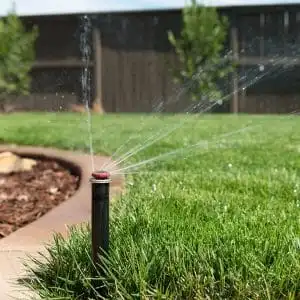It’s sad to see a lush green lawn become lackluster with every passing summer day. But knowing the best way to water your turf is not always common knowledge. How much, how often, and when to water depend on a variety of factors.
If watering your lawn is a worrisome task, there are things you can do to make it easier. Installing an irrigation system is a solution, but it’s often a costly one. If you’re looking to save time and money while cutting back on water waste, a lawn sprinkler may be your best bet.
Is Your Grass Getting Enough Water?
Too much or too little? Giving your grass the right amount of water shouldn’t be guesswork. But knowing the signs of over and under watering will help you keep your lawn green in the summer heat.
Too little? A good indication that your lawn needs hydration is how it responds to foot traffic. As you step on the grass, blades should immediately bounce back up. Other signs that it’s time to water are dried out, curled, or wilted grass blades. Is your soil too dry? Try sticking a shovel or screwdriver into the ground. It’s easier to insert a tool into well hydrated soil than into dry soil.
Too much? On the other hand, too much water is just as damaging. It can lead to diseases like powdery mildew and root rot. And it leads to a shallow root system instead of a long, healthier one. If your lawn feels soggy underfoot for long periods of time, cut back on watering. Other signs you are watering too much are quick growth (and more mowing), limp grass blades, and a thicker layer of thatch.
Types of Sprinklers
Lawn sprinklers come in a variety of styles. Here’s is a description of some common designs to help you determine which one fits your needs.
Fixed or stationary. Easy to use and economical, these sprinklers deliver water through a pattern of holes. They come in different shapes and sizes to suit your needs and work well on smaller areas or gardens.
Impact or impulse sprinklers distribute water in an adjustable circular pattern. Because the jet of water shoots out low to the ground, there’s less evaporation and wind is less likely to disturb the spray.
Oscillating. Remember jumping through fans of water moving back and forth when you were a kid? The oscillating sprinkler features an arched tube with holes. Water shoots upward, creating a gentle spray that works well for delicate plants and newly seeded lawns. However, this type is not good for windy days.
Rotating. One or more arms rotate to spray water in a circular pattern. An efficient way to water larger areas evenly.
Traveling. Attached to a hose, the device moves across your yard with little to no supervision. Your yard must be level to accommodate this sprinkler. Sufficient water pressure is required to keep it going.
Hose. Great for long, narrow areas or gardens, this system features a garden hose with small holes along the top. Because water flow is low, this sprinkler tends to be less wasteful.
Call Us Today
Thick green grass is the sign of a healthy lawn. If you’re lawn is a little lackluster this summer, let us help. Contact Free Spray Lawn Care at 866-373-3777 today!



Comments (0)
Thanks for your comment!
Thanks for your feedback! Your comments have been successfully submitted! Please note, all comments require admin approval prior to display.
Error submitting comment!
There is a problem with your comment, please see below and try again.